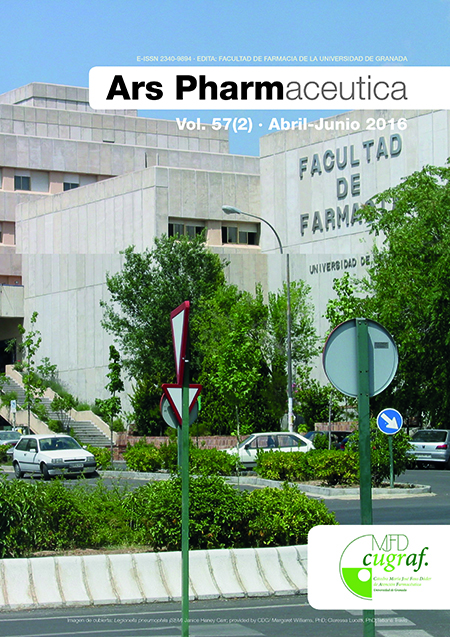Miconazole Microsponges based topical delivery system for diaper dermatitis
DOI:
https://doi.org/10.30827/ars.v57i2.4987Keywords:
Microsponge delivery system, Eudragit RS100, Miconazole Nitrate, Topical Drug Delivery, yeast diaper dermatitisAbstract
Aim: The current investigation was aimed to develop and optimize the microsponges of miconazole nitrate for treatment of diaper dermatitis for enhanced therapeutic effect.
Material and Methods: Microsponges were developed by emulsion solvent diffusion technique using 23 factorial design. Fabricated microsponges were optimized in order to analyze the effects of independent variables on the encapsulation efficiency, particle size, surface topography and in vitro drug release. The optimized formulation was then incorporated into the gel and evaluated.
Results: Particle size of all formulations was found to be uniform and scanning electron microscopy (SEM) indicates spherical shape and porous nature of microsponges. In vitro drug release studies of all formulations revealed the release rate within the range of 67%±0.09 to 80.6%± 0.68 at the end of 12 hours. On its basis, formulation F8 was selected and incorporated into the gel (CF8) which was evaluated for pH, viscosity, spreadability, in vitro drug diffusion studies, in vitro anti fungal studies and stability studies.
Conclusion: The formulated microsponge-based gel of miconazole nitrate would be a capable substitute to traditional treatment for reliable and economical cure of diaper dermatitis.
Downloads
Downloads
Published
How to Cite
Issue
Section
License
The articles, which are published in this journal, are subject to the following terms in relation to the rights of patrimonial or exploitation:
- The authors will keep their copyright and guarantee to the journal the right of first publication of their work, which will be distributed with a Creative Commons BY-NC-SA 4.0 license that allows third parties to reuse the work whenever its author, quote the original source and do not make commercial use of it.
b. The authors may adopt other non-exclusive licensing agreements for the distribution of the published version of the work (e.g., deposit it in an institutional telematic file or publish it in a monographic volume) provided that the original source of its publication is indicated.
c. Authors are allowed and advised to disseminate their work through the Internet (e.g. in institutional repositories or on their website) before and during the submission process, which can produce interesting exchanges and increase citations of the published work. (See The effect of open access).























